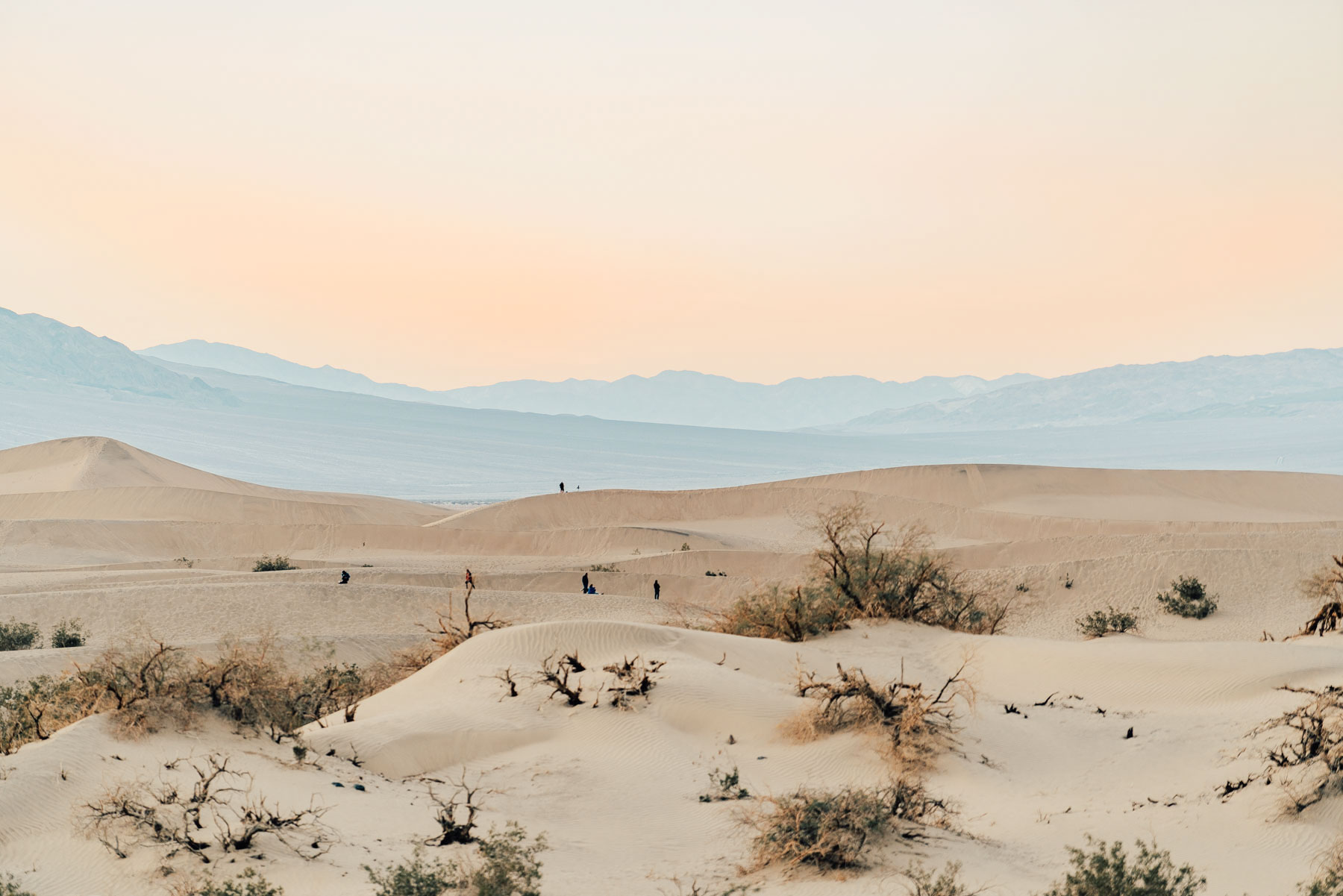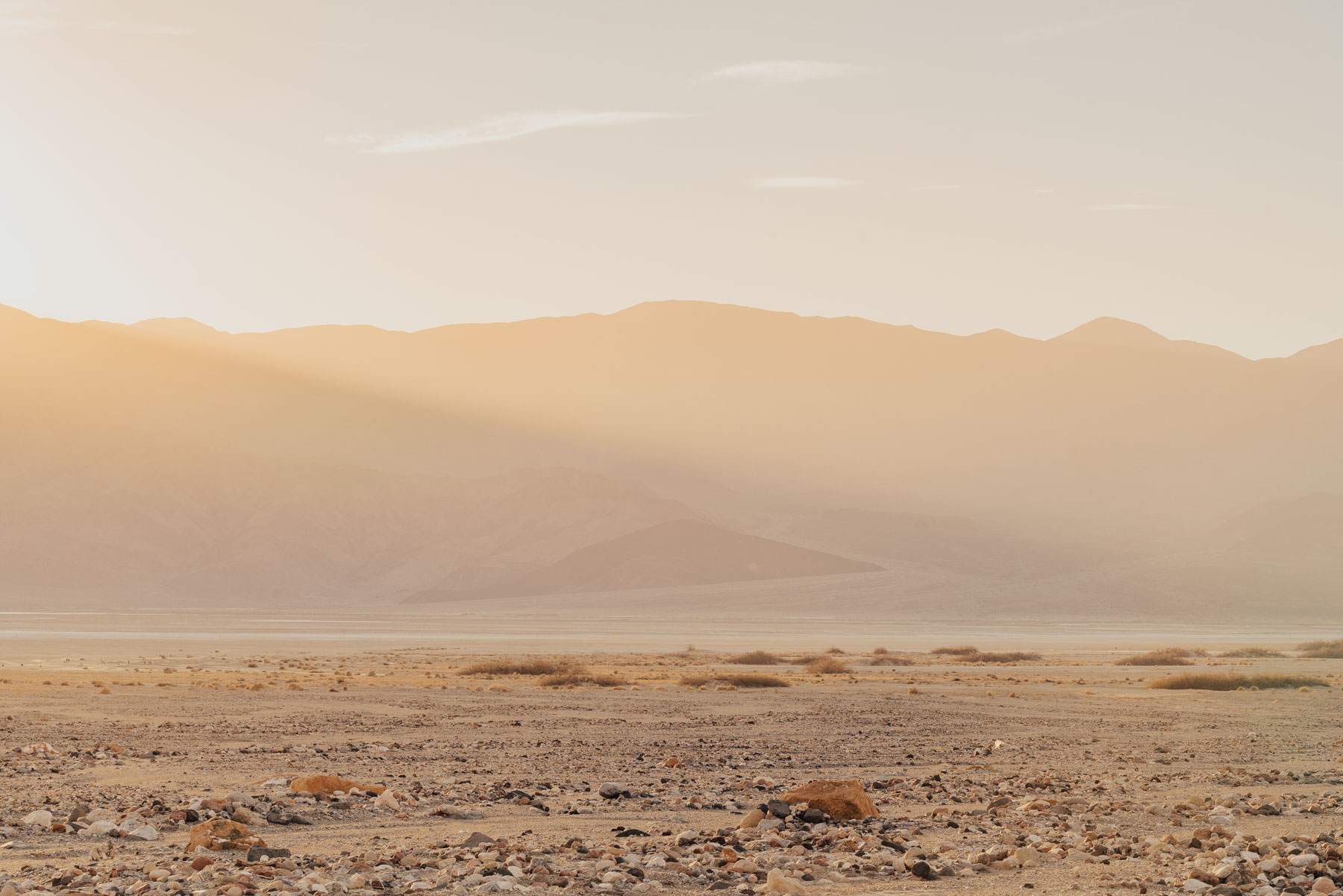Are you looking for things to do in Death Valley National Park?
Look no further. We spent 14 days climbing sand dunes, hiking canyons and stargazing in Death Valley National Park.
We challenged ourselves to see as much as we could during our two-week trip and were completely blown away by the beauty of Death Valley National Park. Not a day goes by that we don’t think of this inspirational and untouched landscape.
Read on for the BEST things to do in Death Valley National Park!
Note: This post contains affiliate links
Tips for Visiting Death Valley National Park
Death Valley Guidebooks
Leave No Trace
Temperature
- Death Valley National Park holds the world record as the hottest place on earth — the heat is no joke. I suggest visiting the park between October and April for comfortable hiking temperatures. Always pack more water than you think you’ll need – here’s the water bottle I’ve been using the last 6 years — it keeps water ice cold for hours (regardless of the heat).
You + Sunscreen = Best Friends (Forever)
- Harsh sun, folks – use sunscreen and apply frequently. Shade is hard to come by and it’s easy to get sunburned in the desert. I swear by this sunscreen, I discovered it in France and now buy it in bulk. You’ll never catch me without it!
Wear hiking boots with good traction
- Even though the hiking trails are well maintained, tripping hazards are still common — set yourself up for success by wearing proper shoes. These are my hiking boots and I’d sleep in them if I could. They’re that good.
Cell service in the park is unreliable
- Make sure you’re well prepared in terms of gas, food and water while visiting Death Valley National Park. We were out of service 90% of the time. (Tip: the best cell service spots we found were at Stovepipe Wells and Furnace Creek).
Hiking with pups
- Dogs are NOT allowed on trails, in wilderness or in buildings. Essentially, pups can only go where cars can go, and this isn’t the place to leave your cute pooch in the car.
You may need a vehicle with 4WD
- Many attractions can be reached with a regular vehicle. However, some parts of Death Valley National park require high-clearance vehicles equipped with 4WD. These areas will be clearly noted below.
- If helpful, I wrote guides on Death Valley with 4WD and without 4WD.
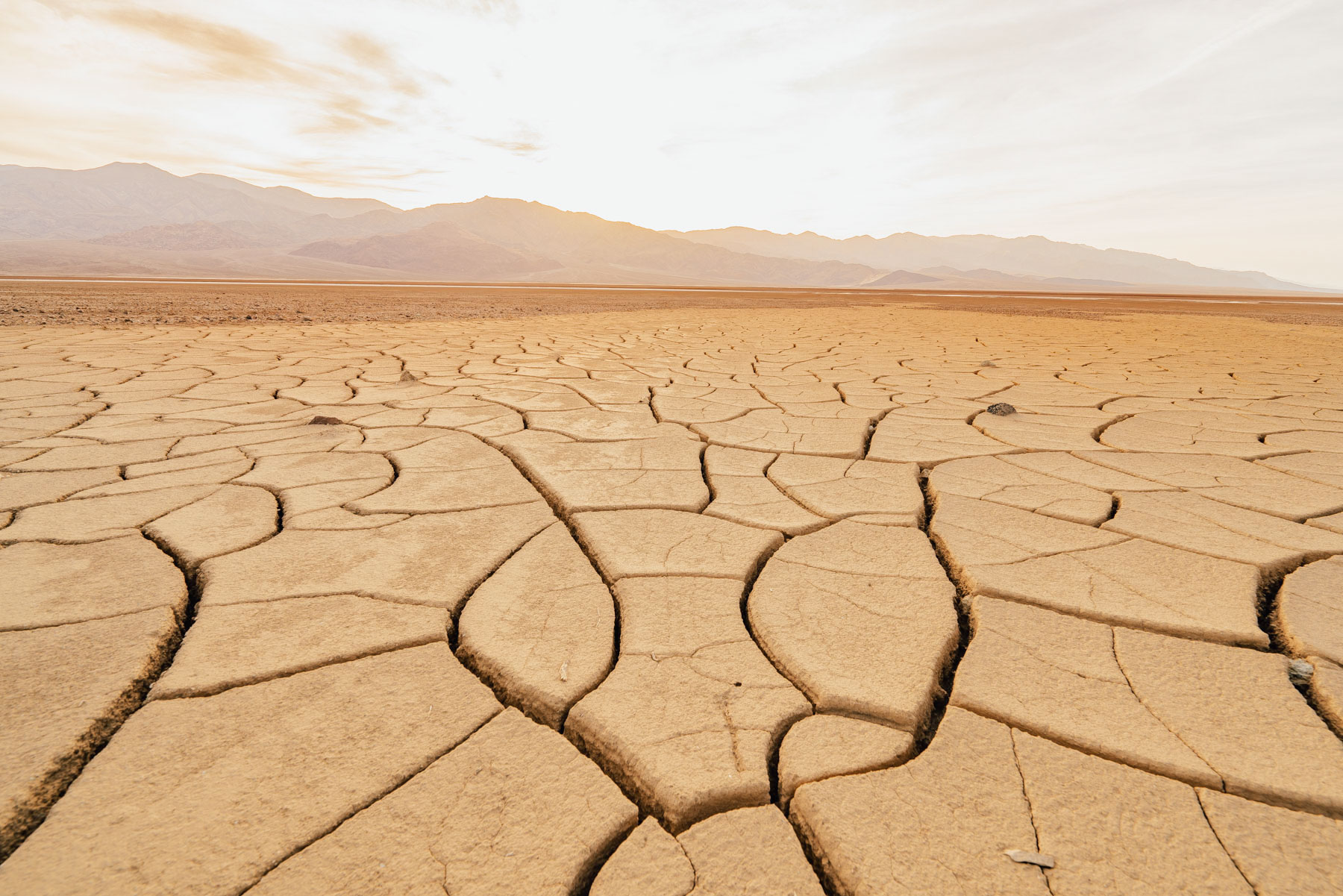
#1. Hike Eureka Dunes
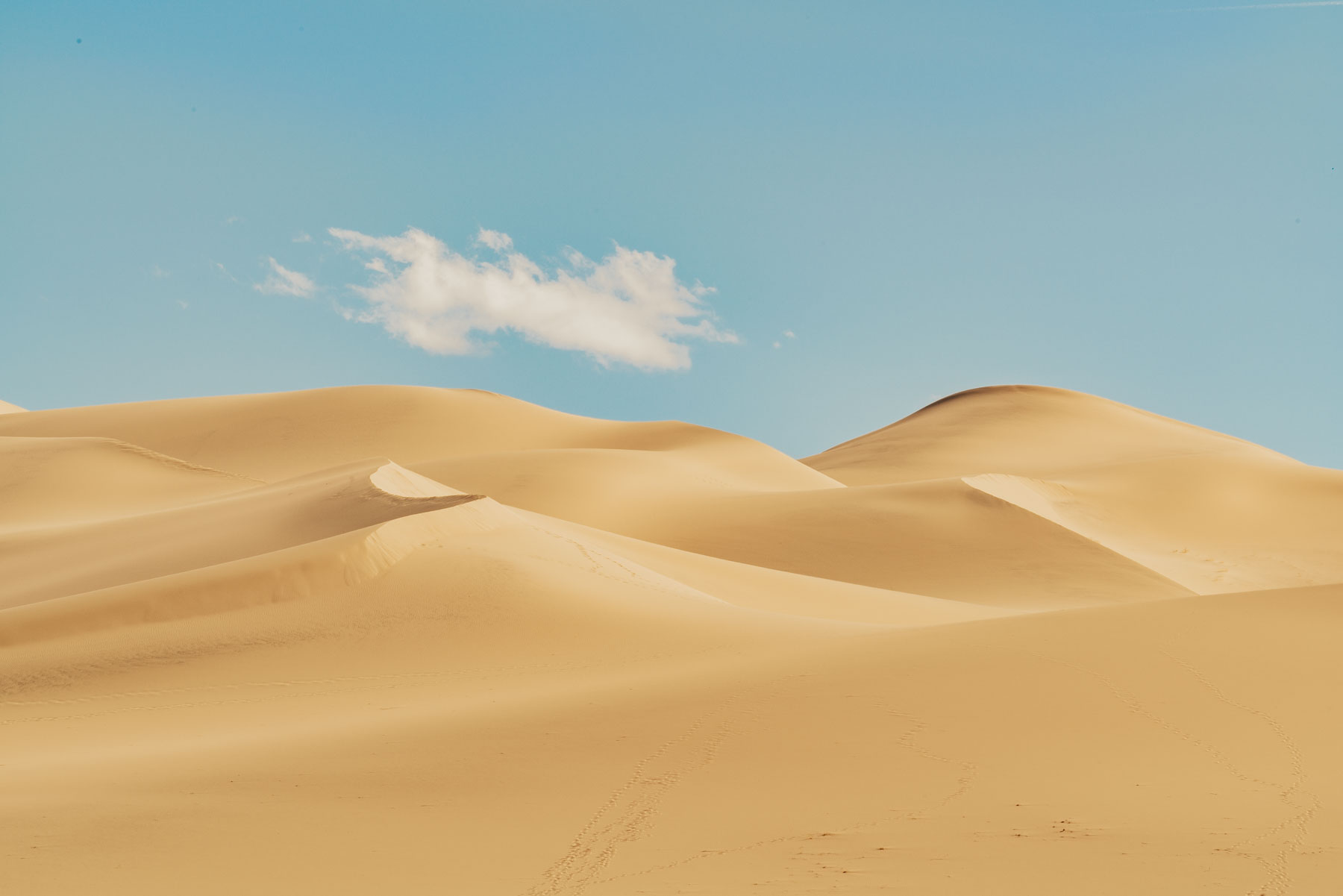
Eureka Dunes is the tallest dune field in California, arguably the entire US. We hiked to the top for sunset and found ourselves perplexed by an unknown sound best described as a mix between howling and humming.
We later learned about this strange phenomena. Turns out it occurs in sand dunes when all the conditions are perfect (think wind) – the sand “sings” how cool is that?!
No one knows exactly why this occurs, the best assumption is the noise is caused by the friction of smooth sand grains sliding against each other.
Eureka Dunes is my favorite dune field in the park, but getting there requires a high clearance vehicle.
We recommend visiting only if you have 4WD, even though the national park service claims standard vehicles could access Eureka Dunes. Personally, we only saw 4WD cars in the parking lot.
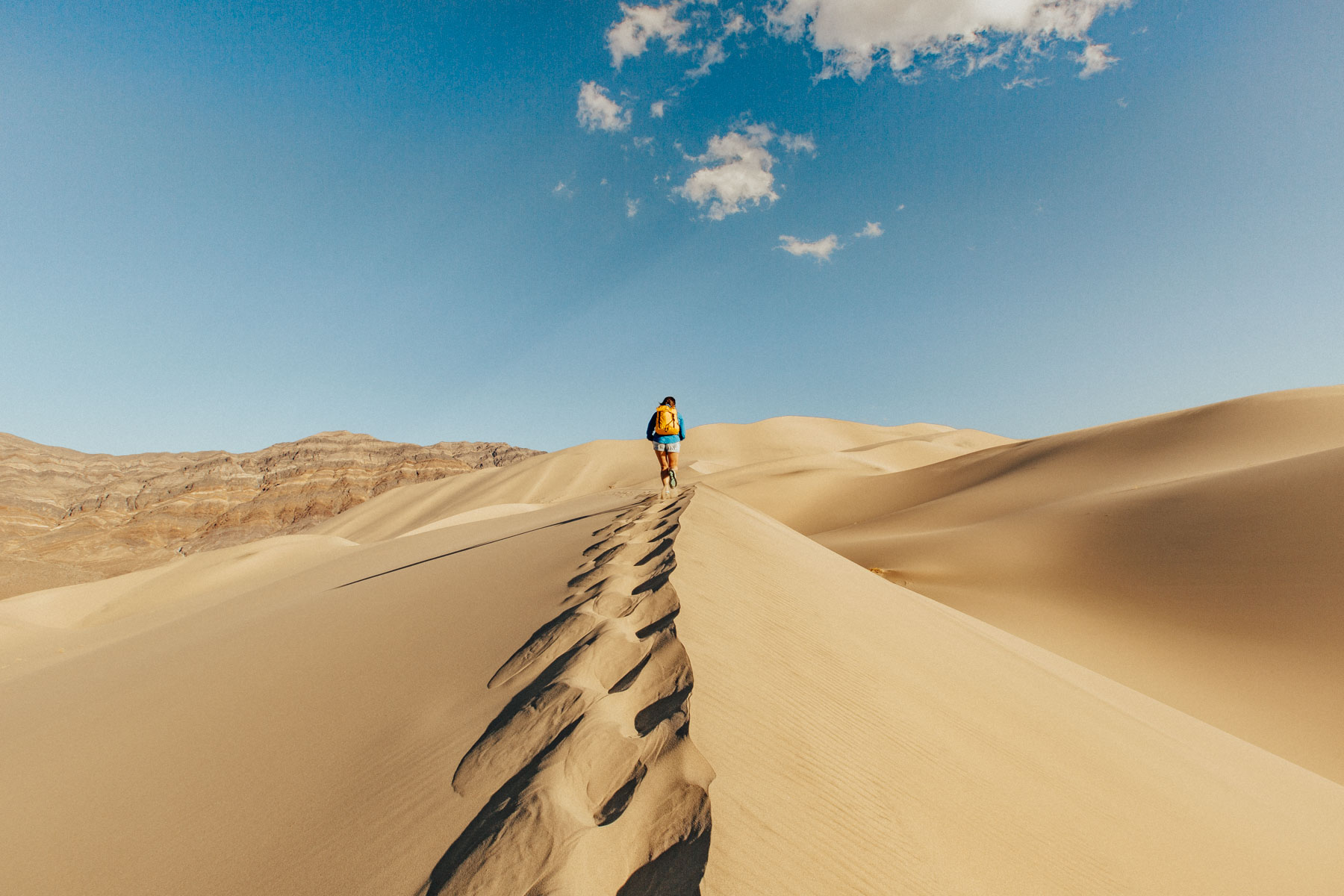
#2. Catch Sunrise at Zabriskie Point
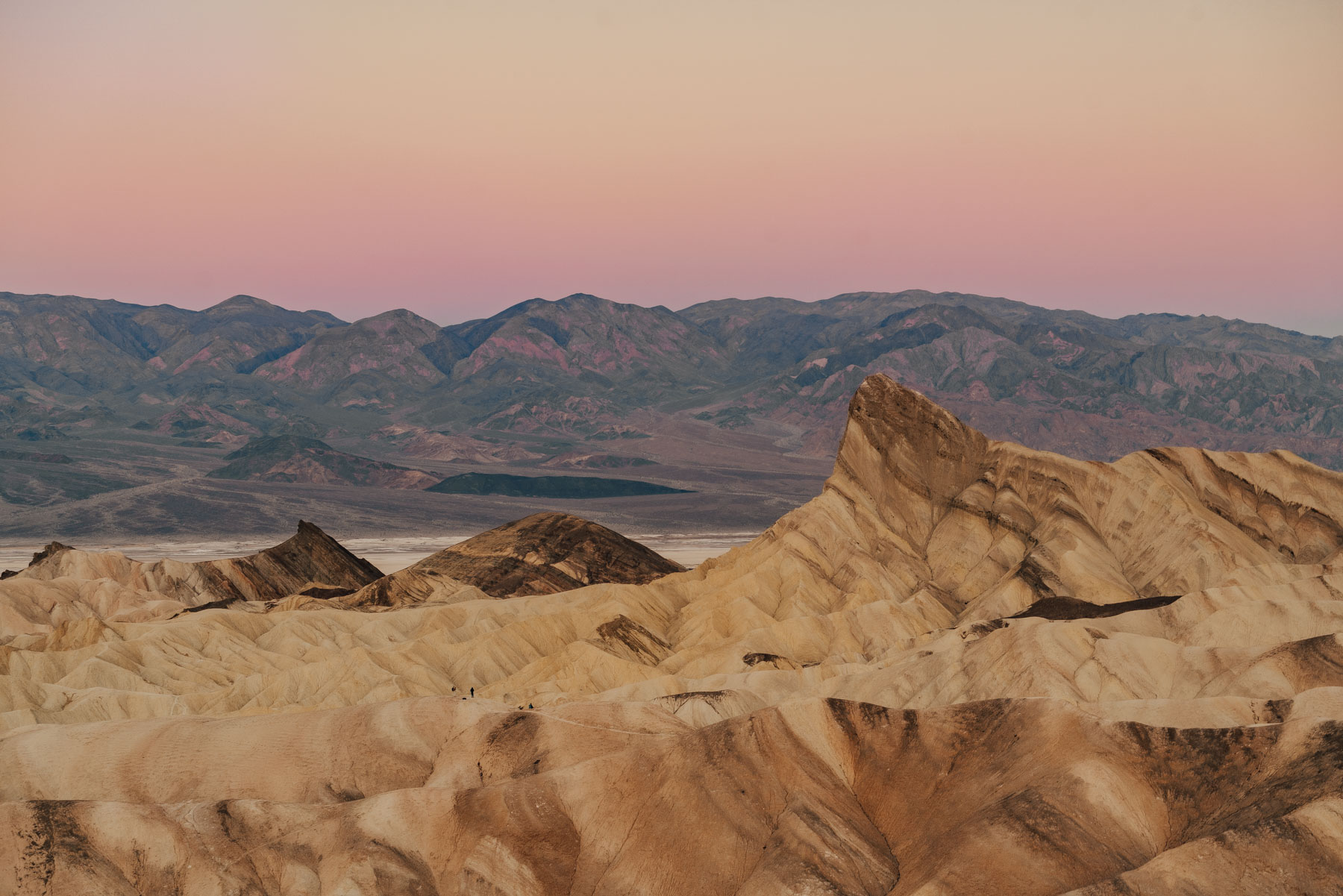
Zabriskie Point is the most photographed spot in the park for good reason – it looks like Mars! This famous point is named after, Christian Brevoort Zabriskie, vice-president of the Pacific Coast Borax Company.
The best part? The hike is accessible to everyone because getting to the lookout doesn’t even require a hike!
From the parking lot, the lookout is a short 5 minute walk up a paved path. The landscape here is unbelievable and can’t be missed, we suggest coming here for sunrise to watch the sun greet the valley floor.
Between the silence, landscape and colorful sky – the experience will leave you speechless.
#3. Hike Ibex Dunes
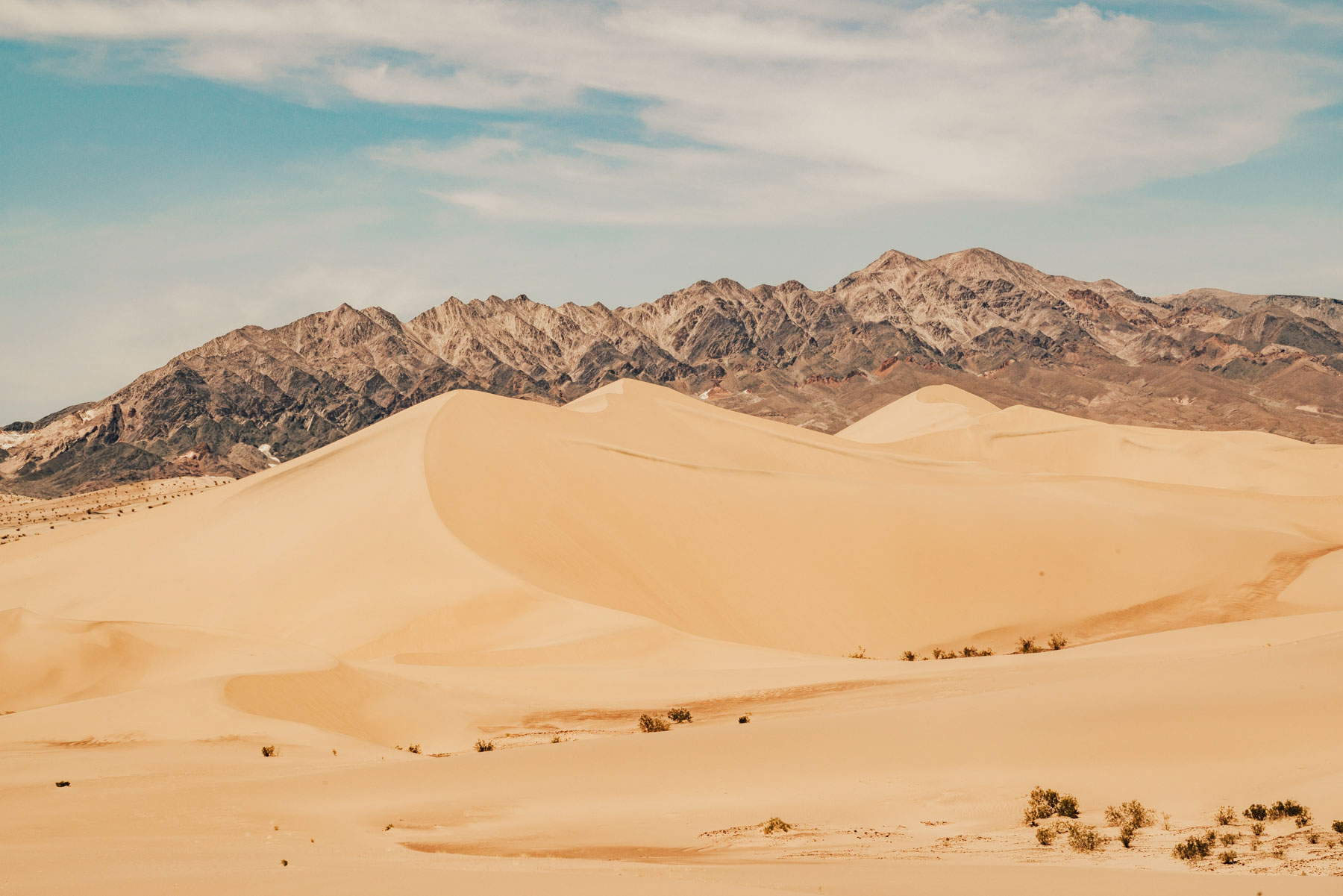
Ibex Dunes is my second favorite dune field in the park. This spot is hard to access because it’s shielded from paved roads and the dirt road is rough!
In fact, in my opinion, this is the roughest road in the park.
With that said, the challenge is rewarding because the solitude cannot be beat – we didn’t run into a single person during our 4-hour hike. The hike leads directly to an abandoned talc mine – such a neat area to explore!
If you have a high clearance vehicle with 4WD, we cannot recommend Ibex Dunes enough! I loved every second of this hike and think you will too.
Visiting Death Valley National Park (Video)
My husband created a video about our time searching for the best things to do in Death Valley National Park. You may notice an appearance by yours truly, plus it won an award from National Geographic. 😉 Hope you enjoy!
#4. Hike to Darwin Falls

We came across a photo of Darwin Falls while researching things to do in Death Valley and assumed it was a photoshopped.
I mean, how could the driest place in America support a waterfall?
But lo’ and behold, Darwin Falls is not only real, it is teeming with wildlife. This easy 2 mile hike is very popular but the unpaved 2.5 mile road to the parking lot is rough!
Darwin Falls is located just west of Panamint Springs.
#5. Artist’s Drive
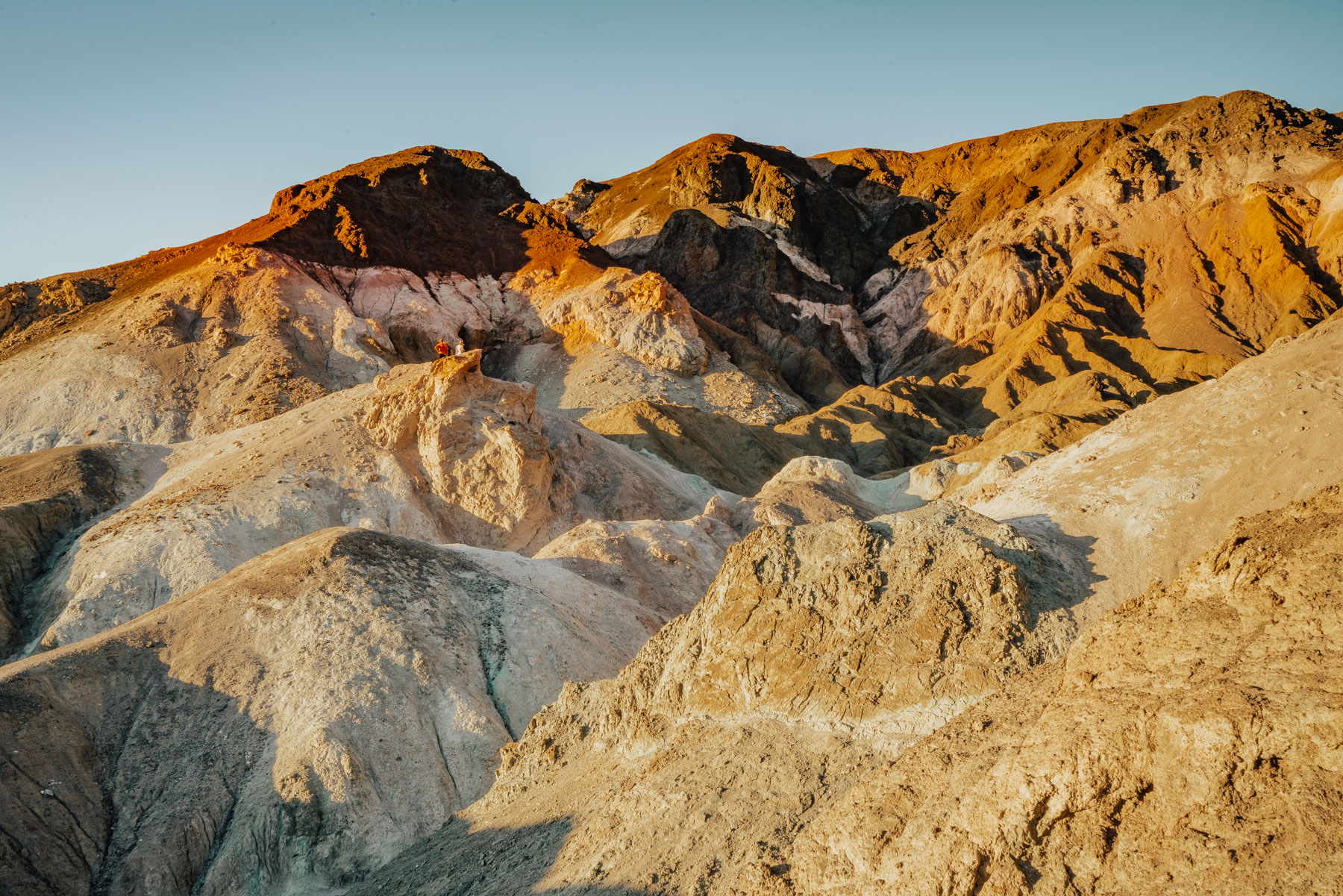
Look at that explosion of color! The colors in these hills are a result of the oxidation of different metals.
Artist’s Drive is a 9-mile drive that takes you down a oneway road leading directly to a parking lot.
The most popular part of the drive is referred to as Artist’s Palette and can be seen approximately 5 miles into the drive.
Once parked, you can hike into the hills. The hike’s length and difficulty depends on you because there isn’t a marked trail, so you can build your own adventure.
This area is easily accessible and simply can’t be missed during your visit to Death Valley National Park!
#6. Sunset at Racetrack Playa
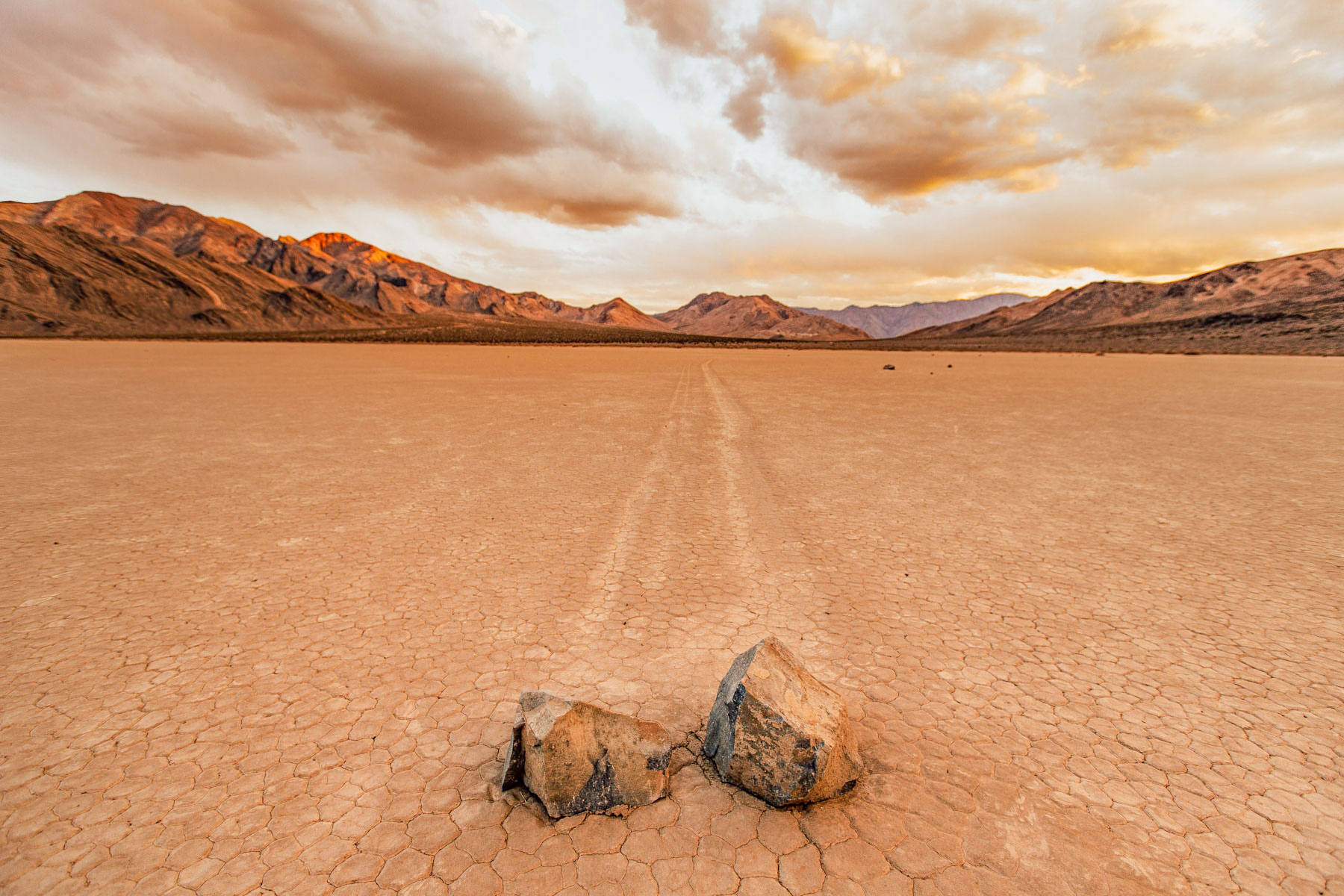
First things first: The road to get here is very rough and made me nauseous. You will need a high clearance, 4WD vehicle with good great tires.
There is no cell coverage in this area of the park, so have spare gas and tires with you because the drive from Furnace Creek is 3.5 hours (each way).
The phenomenon that occurs here has puzzled folks for ages – the rocks move!
Many theories have tried explaining this for years but one in particular sticks out. A research project led by Scripps Institution of Oceanography suggests that when it rains on the playa it becomes extremely slippery.
This, coupled with strong winds of 50 mph or more, pushes rocks along the mud and they leave tracks.It’s amazing to observe this in person and we suggest making the effort to see it.
And, as sad as this is to write, please don’t take the rocks home with you. It’s obvious that some visitors steal these rocks, assuming they’re magic.
Helpful tip: There are three parking lots at the Racetrack, in order to see the moving rocks, you will need to drive to the furthest one down (2 miles south of the Grandstand parking area).
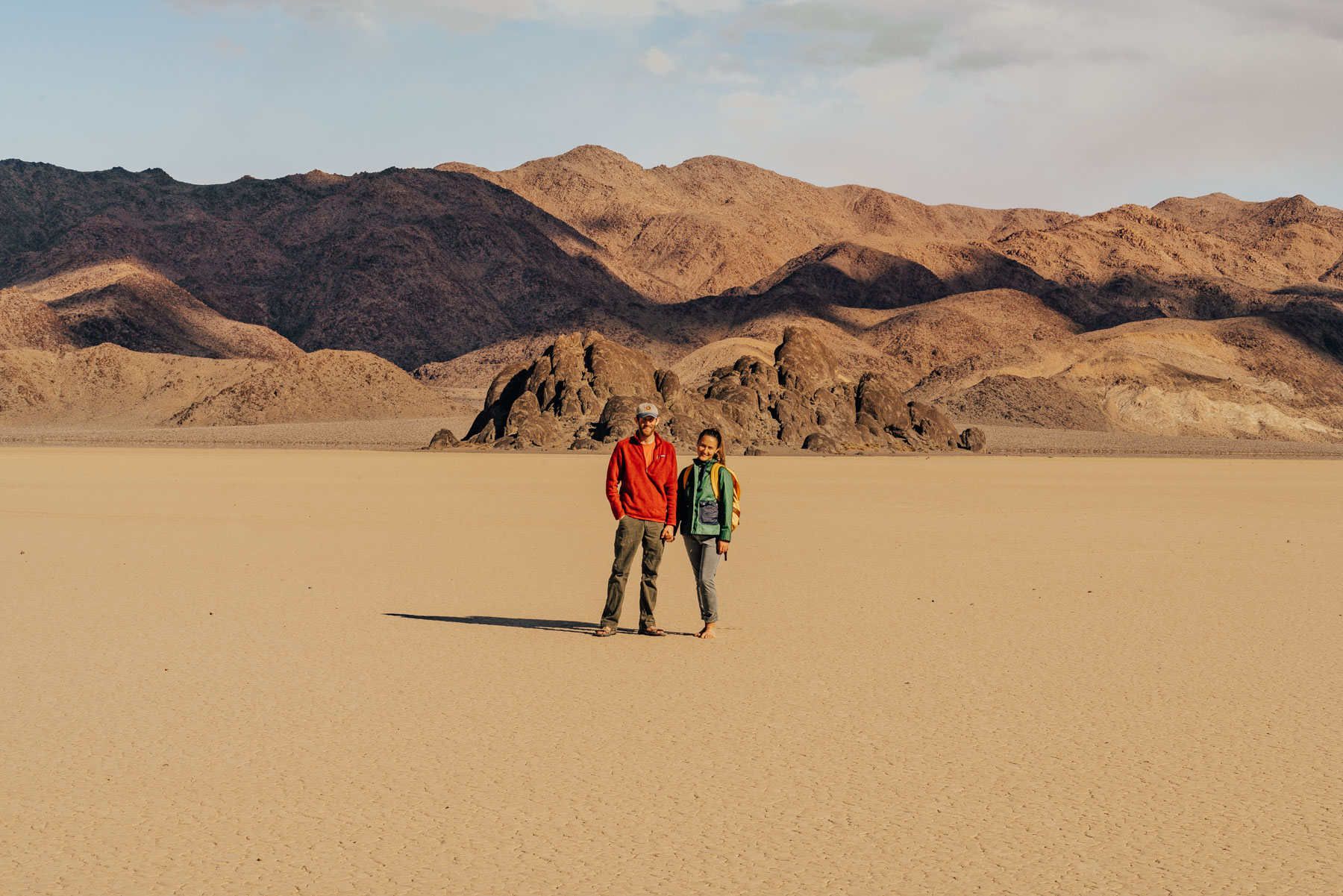
#7. Hike the Golden Canyon
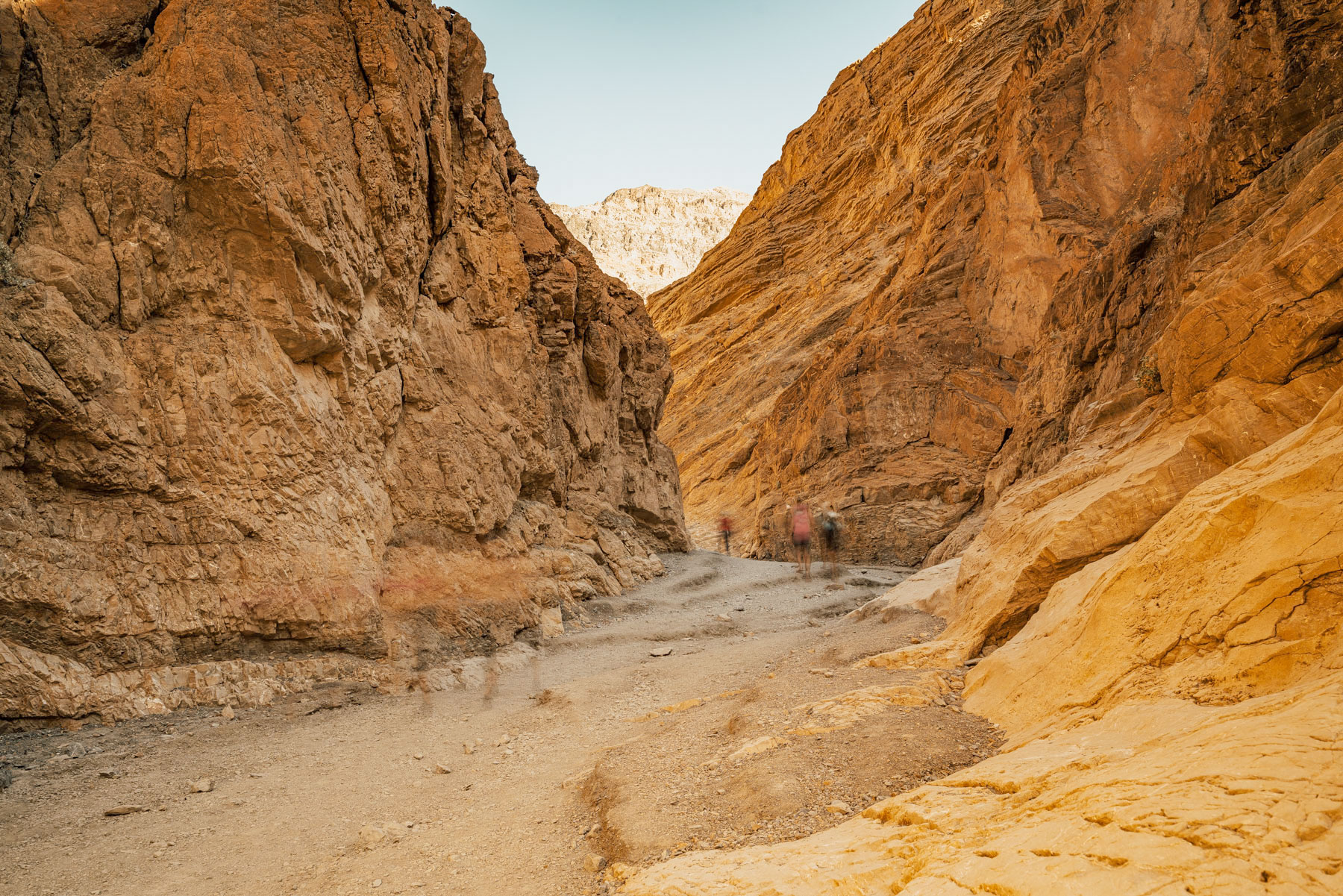
Golden Canyon seems to be one of the most popular hikes in the park so the parking lot fills quickly. There are so many hiking options in Golden Canyon and you can tailor your adventure to your needs.
We hiked to the Red Cathedral and had an absolute blast doing so!
The most popular hikes at the Golden Canyon are:
- Badlands Loop (moderate hike, 2.7 miles, 1.5 to 2 hours )
- Golden Canyon to Red Cathedral (moderate hike, 3 miles, 1.5 to 2 hours)
- Gower Gulp Loop (moderate hike, 4.3 miles, 2.5 hours)
- The Complete Circuit (hard hike, 7.8 miles, 4.5 hours)
#8. Natural Bridge
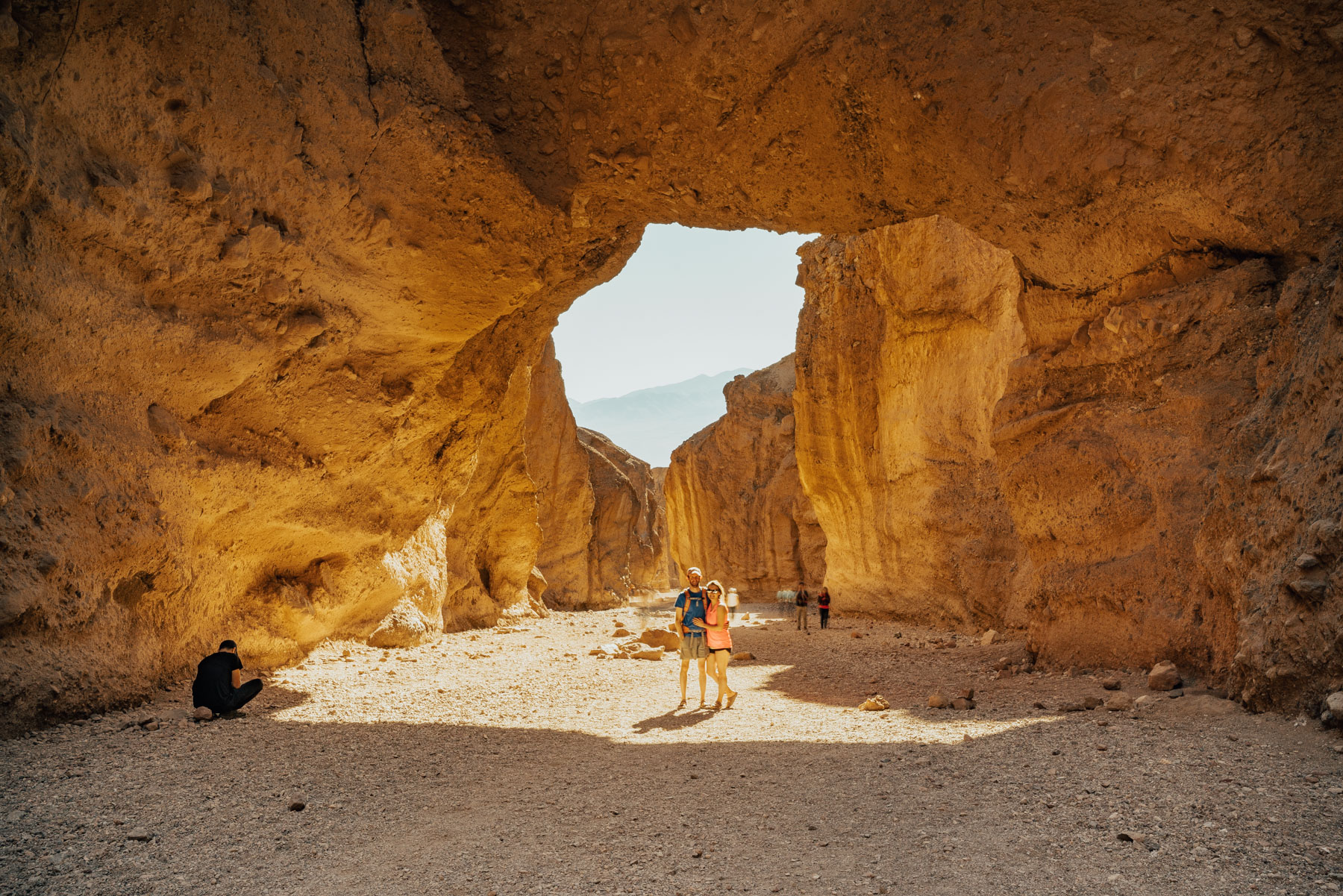
This is an easy one mile hike to a natural arch bridge. The hike is relatively flat and takes about 45 minutes to complete, so it’s a great way to get the jitters out, especially with kids.
To get to the hike you take the unpaved Natural Bridge Road which is 13.5 miles south of CA-190 on Badwater Road.
We enjoyed the hike because it was easy and thought the arch was cool, we recommend seeing it.
#9. Mosaic Canyon
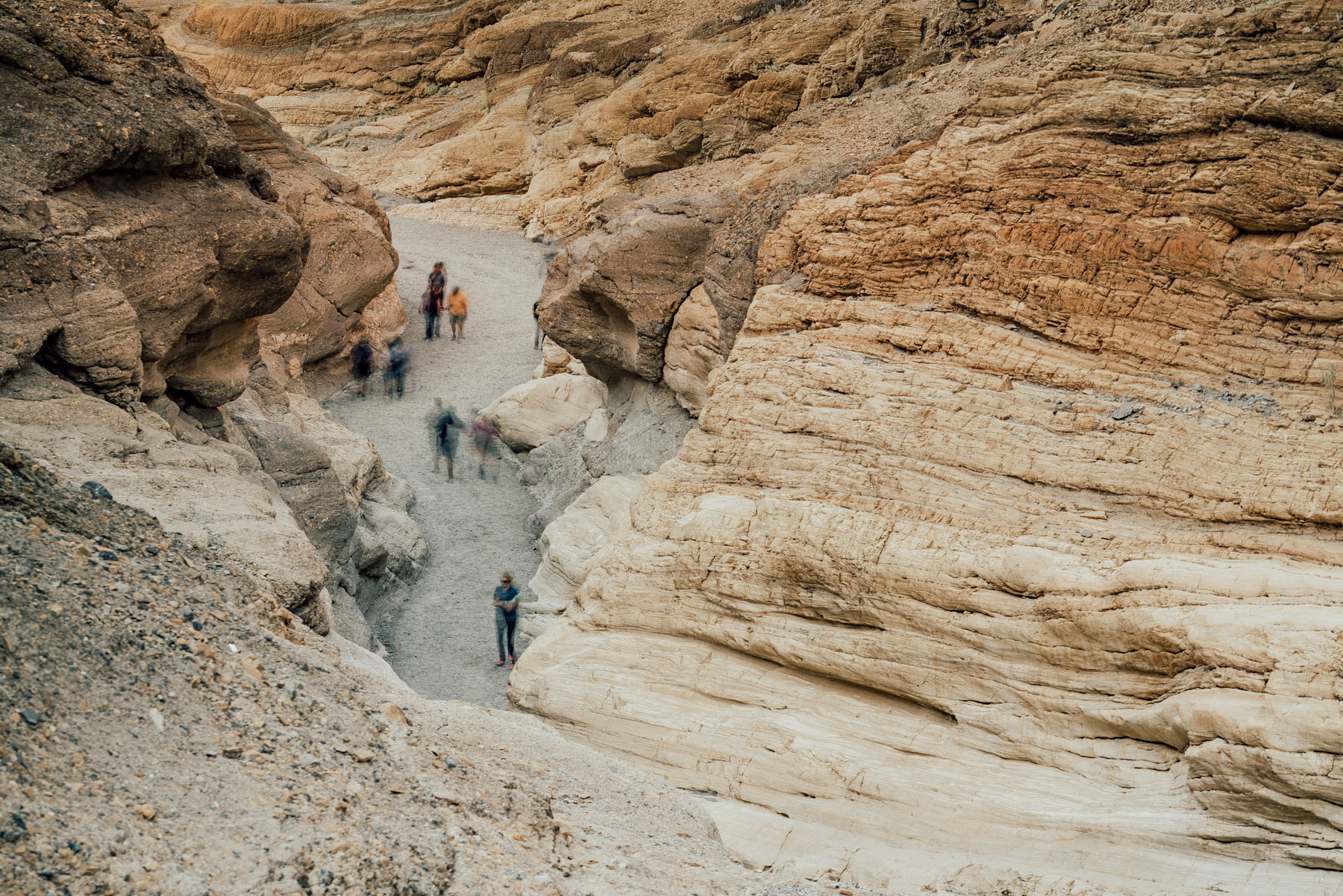
We had a great time hiking through Mosaic Canyon, especially the narrows! The first set of narrows is encountered less than half a mile into the canyon and the entire hike is 4 miles roundtrip.
We hiked two miles in and couldn’t get over the marble. We highly recommend this hike.
#10. Stargaze at the Charcoal Kilns
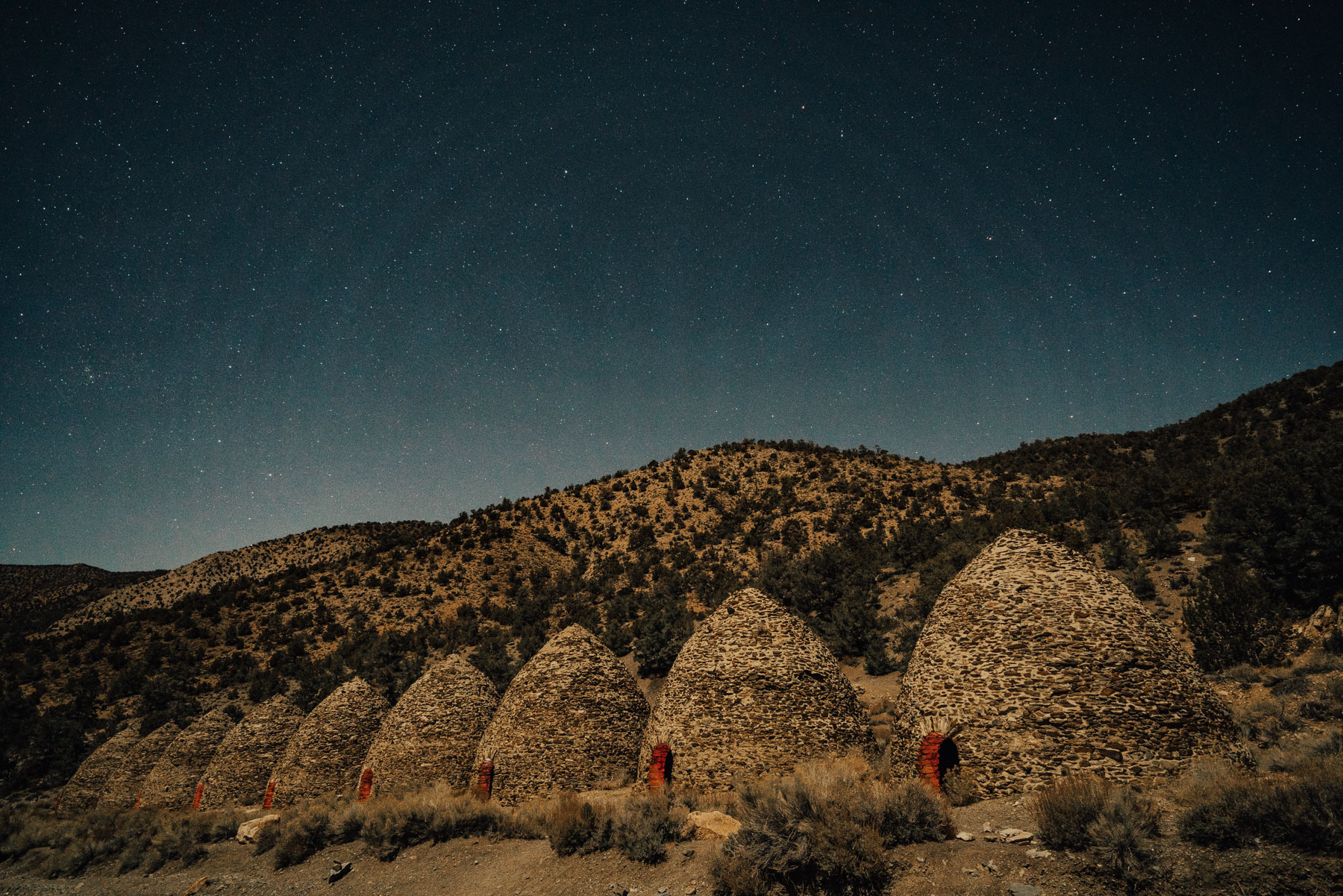
These ten bee-hived structures are believed to be the best known surviving kilns in the western states. Reaching the charcoal kilns is easy because most of the drive is paved road. However, the last 2 miles are gravel and we suggest having a vehicle with high clearance.
The kilns are accessible right from the parking lot and exploring is encouraged! We highly recommend this spot!
#11. Explore Badwater Basin
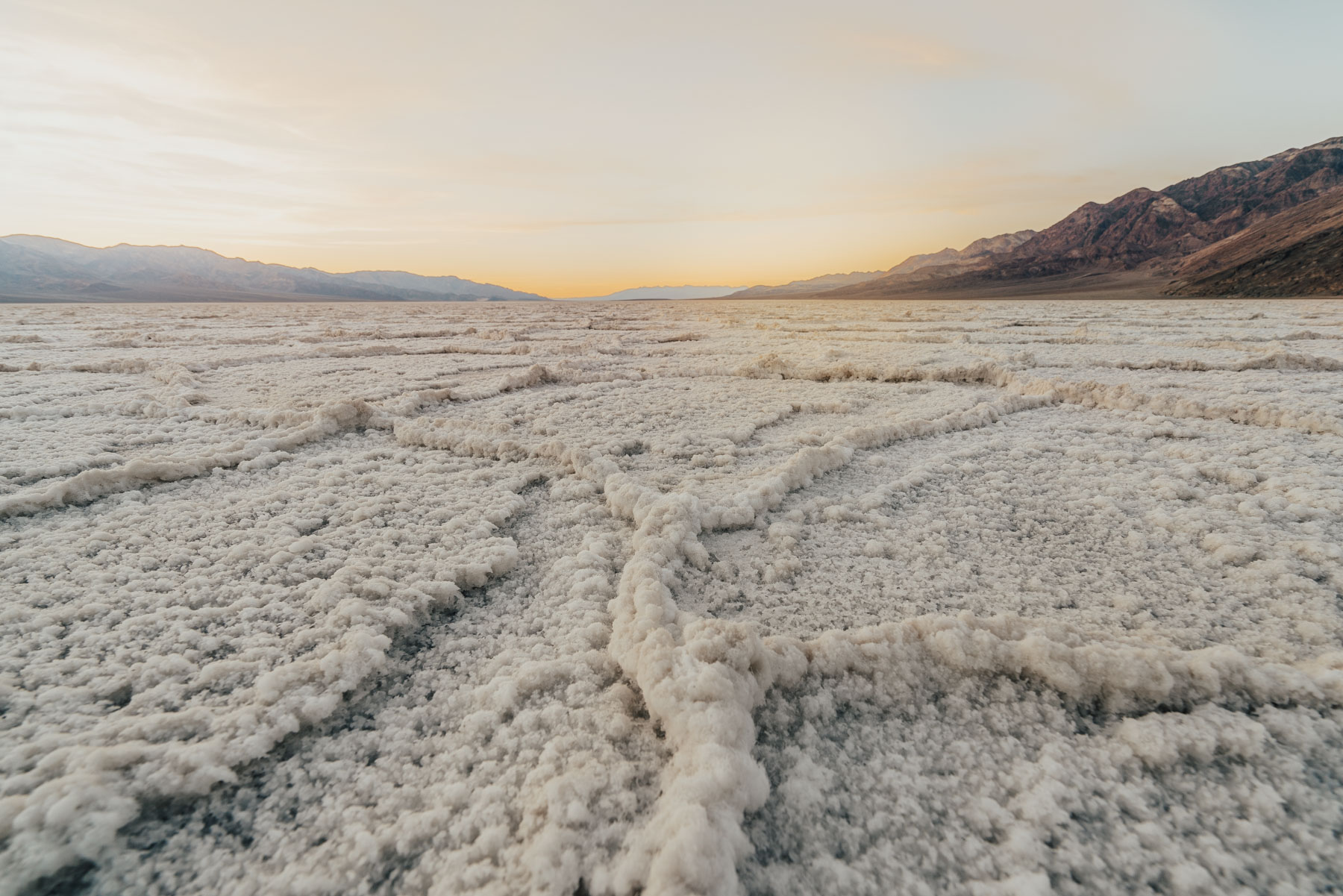
Welcome to the lowest point in America – a whopping 282 feet below sea level. The salt buildup here is unbelievable, massive crystals of salt forming hexagon shapes! This area if very popular, so parking fills up fast.
Once parked, there’s an informational sign that explains the history and facts of this area. A boardwalk will lead you directly to the salt flats, at which point you are allowed to walk on the salt, being mindful of its fragility.
“At Badwater, significant rainstorms flood the valley bottom periodically, covering the salt pan with a thin sheet of standing water. Each newly-formed lake does not last long though, because the 1.9 inches of average rainfall is overwhelmed by a 150-inch annual evaporation rate. This means that even a 12-foot-deep, 30-mile-long lake would dry up in a single year.”
Fun fact: Badwater Basin was considered the lowest point in the Western Hemisphere until the discovery of Laguna del Carbon in Argentina, at 344 feet below sea level.
#12. Hike Mesquite Flat Dunes
Mesquite Flat Dunes are the best known and easiest to visit in the park. They are located near Stovepipe Wells and are the only dunes in the park where sand boarding is allowed, but be mindful of wildlife and sensitive plants.
Challenge yourself to climb the highest dune in this field, it’s 100 feet high. Because Eureka Dunes is so easily accessible, we recommend visiting! It’s just hard for us to compare these dunes to Eureka, we are now biased.
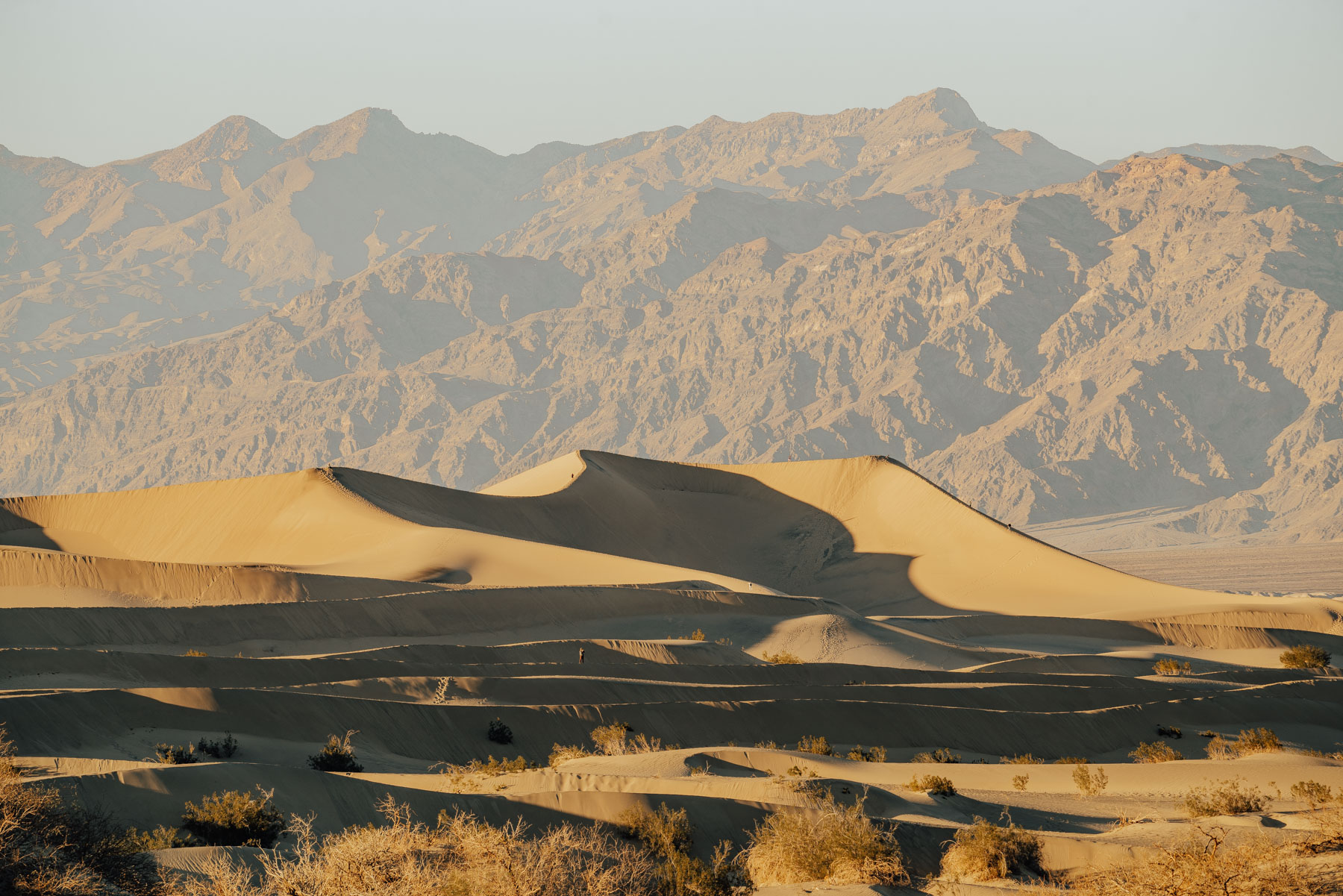
#13. Sunrise at Aguereberry Point
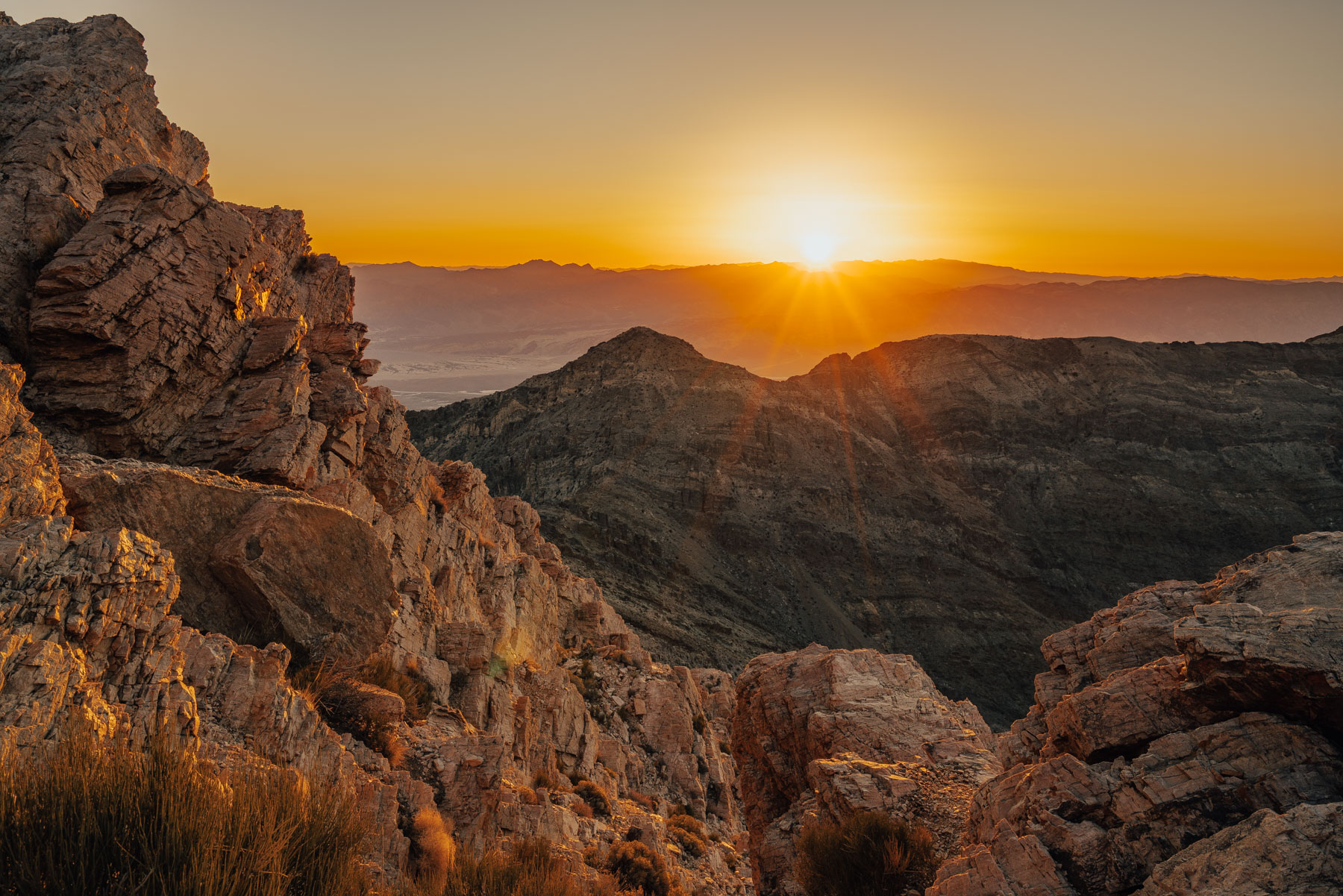
Aguereberry Point is a prominent viewpoint that provides stunning 365 degree views of Death Valley.
From this area, you will see the Panamint mountain range, Death Valley, Furnace Creak and Badwater Basin. If that’s not enough, you’ll also see Mount Charleston in Nevada.
A lot of people go to Dante’s View for the sweeping landscape, but few realize that Aguereberry Point is at a higher elevation by 1,000 feet. Therefore, this spot cannot be beat for sunrises! The road in is rough and we were glad we had 4WD.
#14. Visit the Lee Flat Joshua Trees
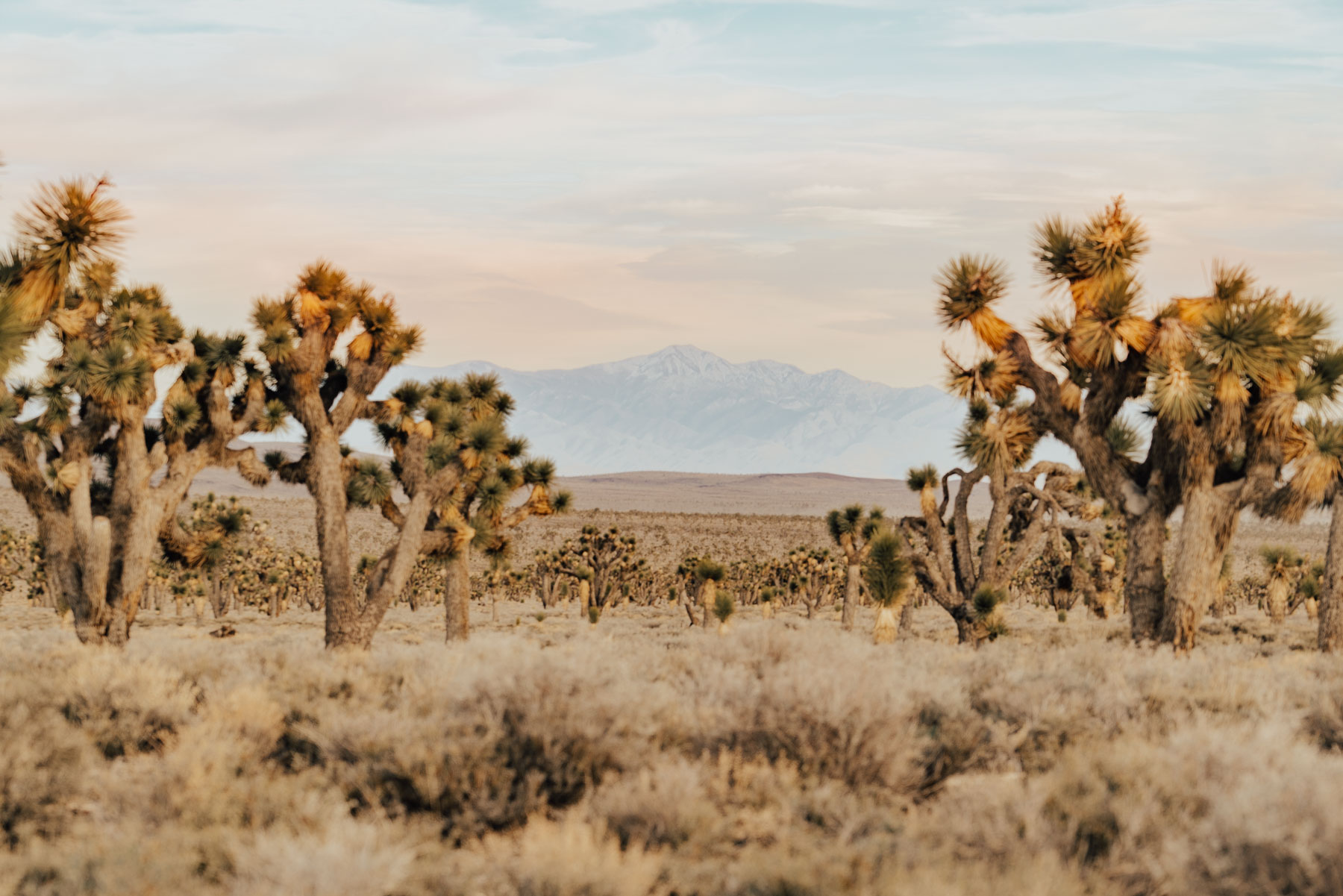
Imagine tree-sized yuccas as far as the eye can see, completely surrounded by romantic rolling hills and snow-peaked mountains. Catching a sunset at Lee Flat feels like the opportunity of a lifetime because this area is so beautiful!
To get to the Joshua Trees you will take the Saline Valley Road (rocky but paved) to a junction in Lee Flat. We caught a sunset here and the color of the sky was unbelievable! We suggest having 4WD for this drive.
#15. Hike Ubehebe Crater and Little Hebe Crater
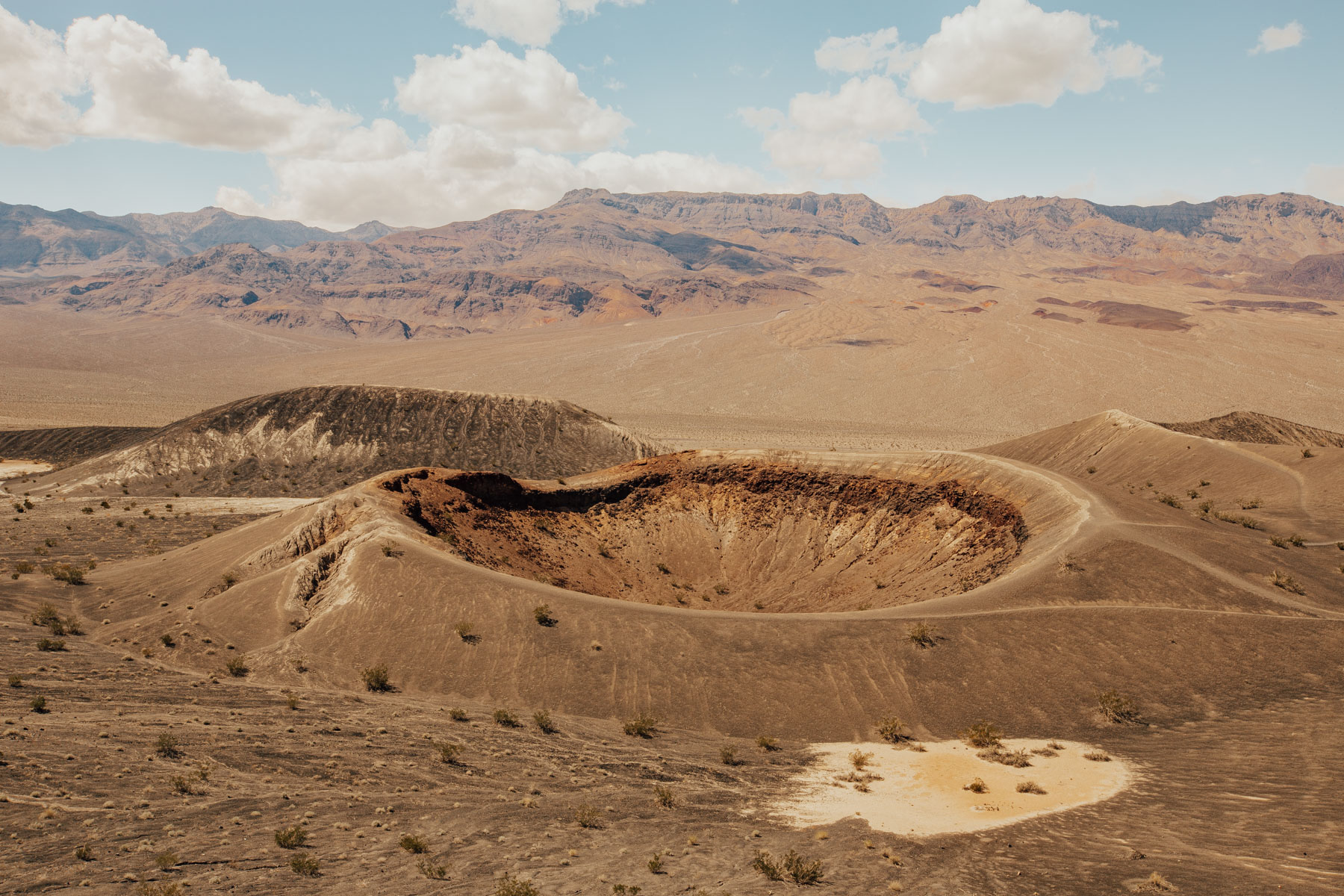
Ubehebe Crater, pronounced U-BE-HE-BE, is a large volcanic crater 600 feet deep and half a mile across.
The craters here are known as maar volcanoes and are created by steam and gas explosions. Ubehebe Crater can be viewed from the parking lot, so hiking is not required.
If you’re in a hiking mood, you have two options: Hike to the bottom of Ubehebe Crater or hike to Little Hebe Crater.
The hike to the bottom of Ubehebe is easy on the way down but very tough on the way up. We saw people struggling. The steep(ish) hike to Little Hebe Crater via the rim of Ubehebe Crater is 1.5 miles roundtrip. We chose to hike to Little Hebe Crater and thought the view was spectacular – look at that crater formation!
#16. Climb Panamint Dunes
Panamint Dunes are interesting because they are perched on a slope, as opposed to a flat valley floor. These dunes don’t seem heavily trafficked because the 5-mile unmarked dirt road is quite rough to drive.
Not only is the road rough, it only takes you as close as 3 miles to the dunes, at which point you would have to hike.
In short, you have to work for these dunes! We decided to drive down the road but did not hike on the dunes, however, we came across an interesting rusty car and a cool tree stump.
In our opinion, the drive was worth it, but if you don’t have 4WD, we think this can be skipped.
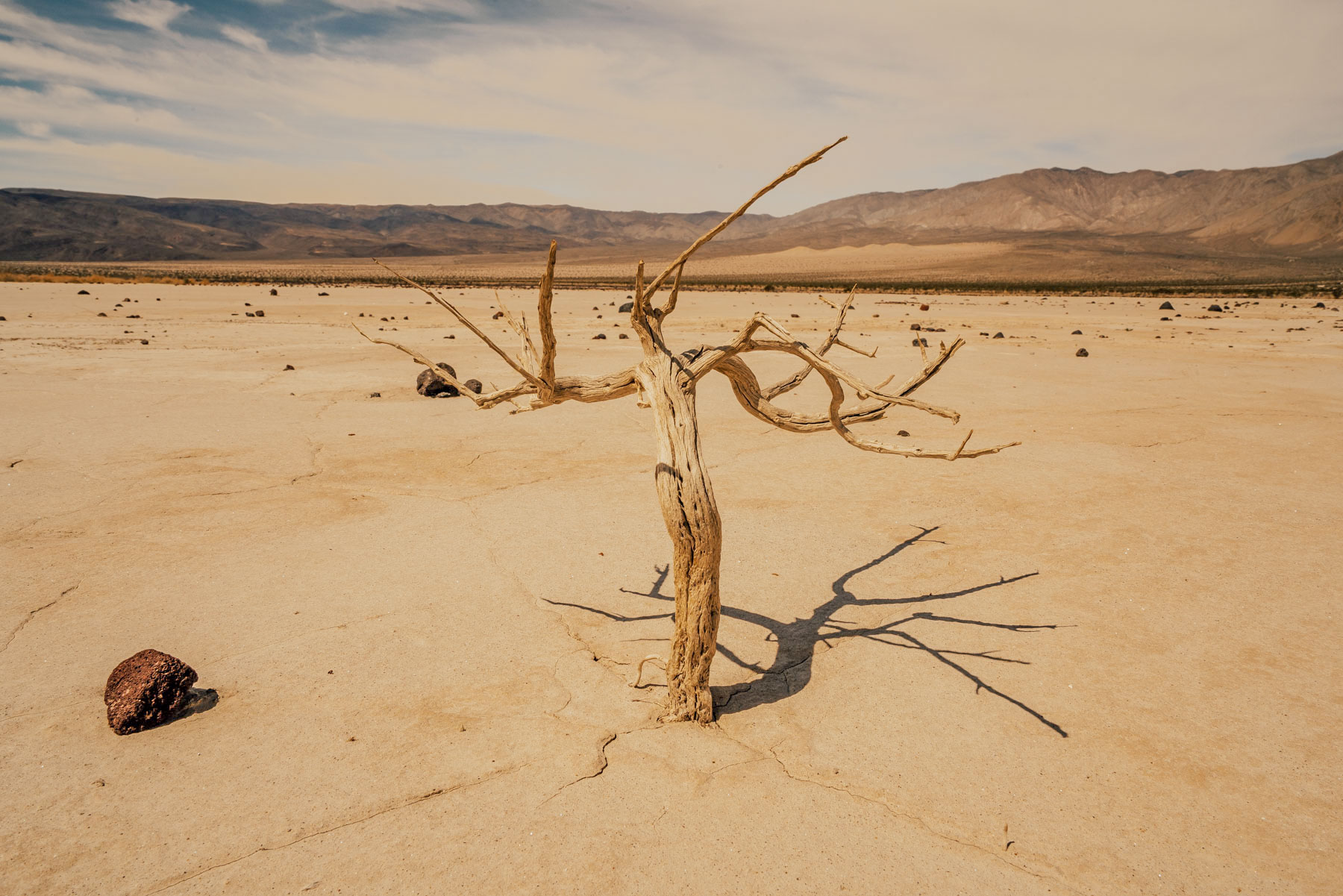
#17. Stargaze at Death Valley National Park
Death Valley National Park is a phenomenal place for stargazing, in fact, it has a Gold Tier Rating as an International Dark Sky Park. It is one of the darkest places in the US because it is so far removed from light pollution.
- The three best places to stargaze are:
- Harmony Borax Works
- Mesquite Flat Sand Dunes
- Badwater Basin
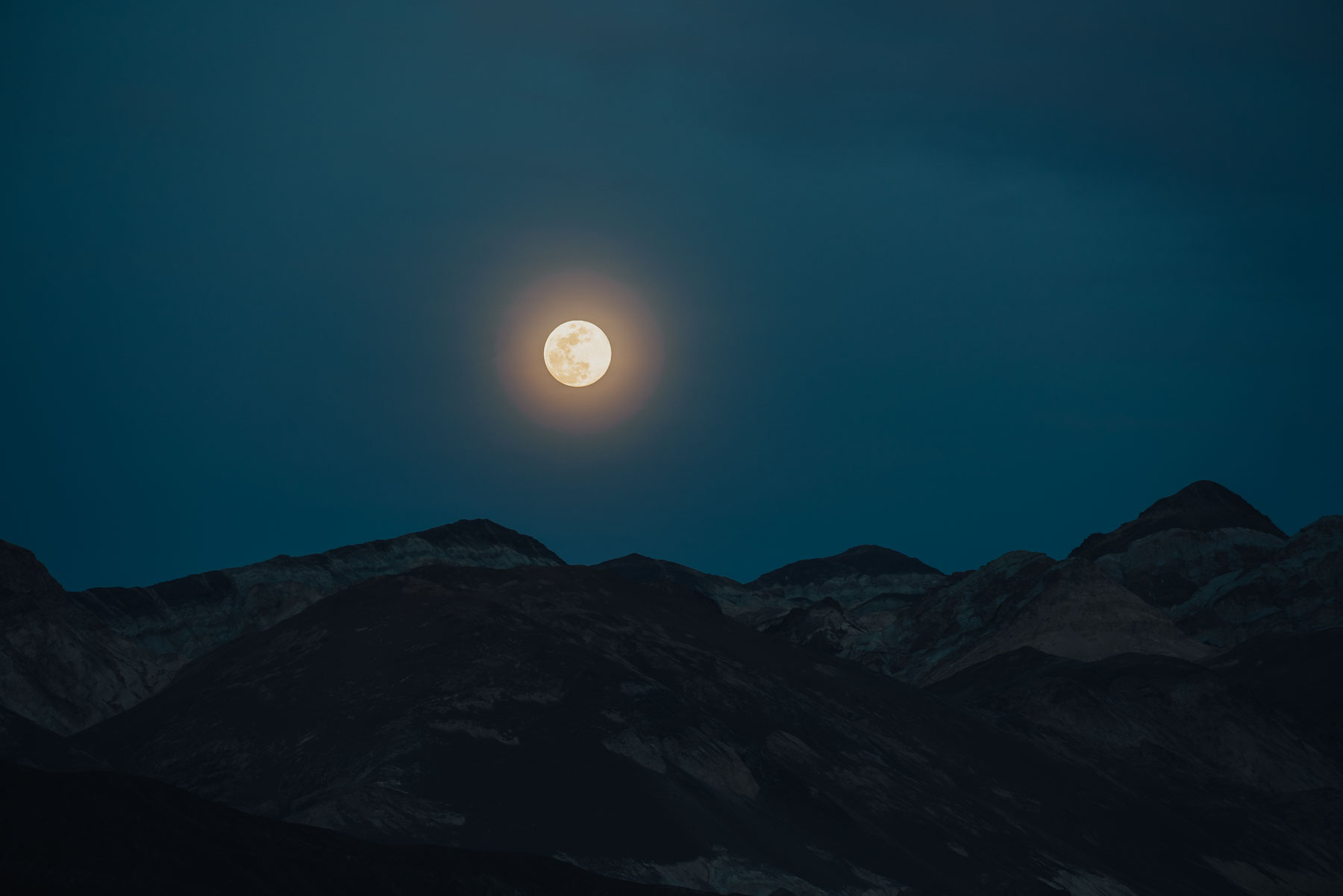
Where is Death Valley National Park?
Death Valley National Park is located in eastern California and spills into Nevada. Even though most of the park is in California, the closest major airport and metro area is Las Vegas.
The quickest route from Vegas to Death Valley is 135 miles and takes about 2.5 hours, without stops.
Best Time to Visit Death Valley
- Temperatures are most comfortable between the months of November and March when the highs range between 65 and 82 degrees.
- If you’re hoping to catch wildflowers, different elevations experience blooms at different times of year, this link might be helpful.
Lodging & Camping
- There are three places to lodge within the park:
- We camped around and found it easy and enjoyable. If you are interested in camping too, there are nine designated camping spots to choose from, click here for information.
Restaurants in Death Valley National Park
- Death Valley National Park has four (over-priced) restaurants:
- The Inn at Death Valley
- Toll Road
- Badwater Saloon
- Panamint Springs Restaurant
- Since prices for mediocre food are on the high side, we chose to bring a cooler and stove and made all our meals. We made eggs for breakfast, sandwiches for lunch and mac & cheese/veggies for dinner. We saved a lot of money by cooking our own meals.

Driving & Gas
There are three gas stations in the park. The price per gallon is about $1-2 more expensive than outside the park, so be prepared for that.
- Furnace Creek | Open 24 hours | Unleaded fuel and diesel
- Stovepipe Wells Village | Open 24 hours | Unleaded fuel ONLY
- Panamint Springs | Open 7am – 9:30pm | Unleaded fuel ONLY
We cannot stress enough just how BIG Death Valley is, make sure you ALWAYS have a spare tire, extra water and extra gas.
Some points of interest are literally hours apart in each direction. You don’t want to get stranded because the average towing fee hovers at $2,000.
What’s worse, you might be waiting hours or even days for someone to drive by and the best they can do is alert a ranger when they reach the visitor center.
Helpful Resources
We hope you enjoyed this helpful guide for things to do in Death Valley National Park.
And now to you. Have you visited Death Valley National Park Before? What was your experience?
Things to do at Death Valley National Park, Things to do in Death Valley, things to do at Death Valley National Park things to do at Death Valley National Park, things to do in Death Valley National Park Things to do at Death Valley National Park, Things to do in Death Valley, things to do at Death Valley National Park things to do at Death Valley National Park, things to do in Death Valley National Park Things to do in Death Valley, things to do at Death Valley National Park things to do at Death Valley National Park, things to do in Death Valley National Park Things to do in Death Valley, things to do at Death Valley National Park things to do at Death Valley National Park, things to do in Death Valley National Park
Until next time,
Antonina
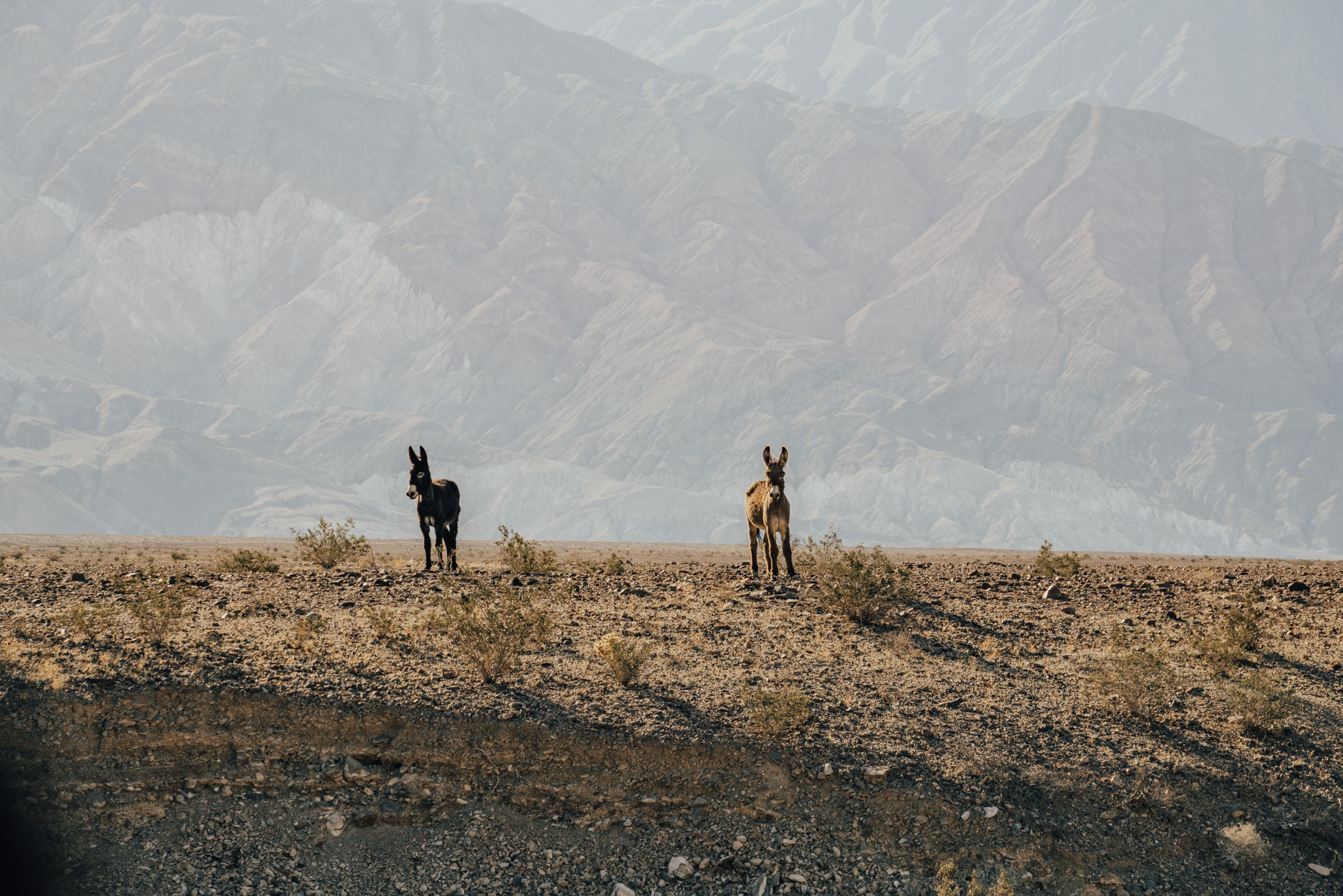
Visitor Center, Death Valley National Park Visitor Center,
What to do in Death Valley, Death Valley things to do, things to do in Death Valley National Park, what to do in Death Valley, what to do in Death Valley, What to do in Death Valley, Death Valley things to do, things to do in Death Valley National Park, what to do in Death Valley, what to do in Death Valley, What to do in Death Valley, Death Valley things to do, what to do in Death Valley National Park, what to do in Death Valley, what to do in Death Valley, What to do in Death Valley, Death Valley things to do, what to do in Death Valley National Park, things to do in Death Valley, things to do in Death Valley, What to do in Death Valley, Death Valley things to do, what to do in Death Valley National Park, what to do in Death Valley, what to do in Death Valley,
Things to do at Death Valley National Park, Things to do in Death Valley, things to do at Death Valley National Park things to do at Death Valley National Park, things to do in Death Valley National Park Things to do at Death Valley National Park, Things to do in Death Valley, things to do at Death Valley National Park things to do at Death Valley




